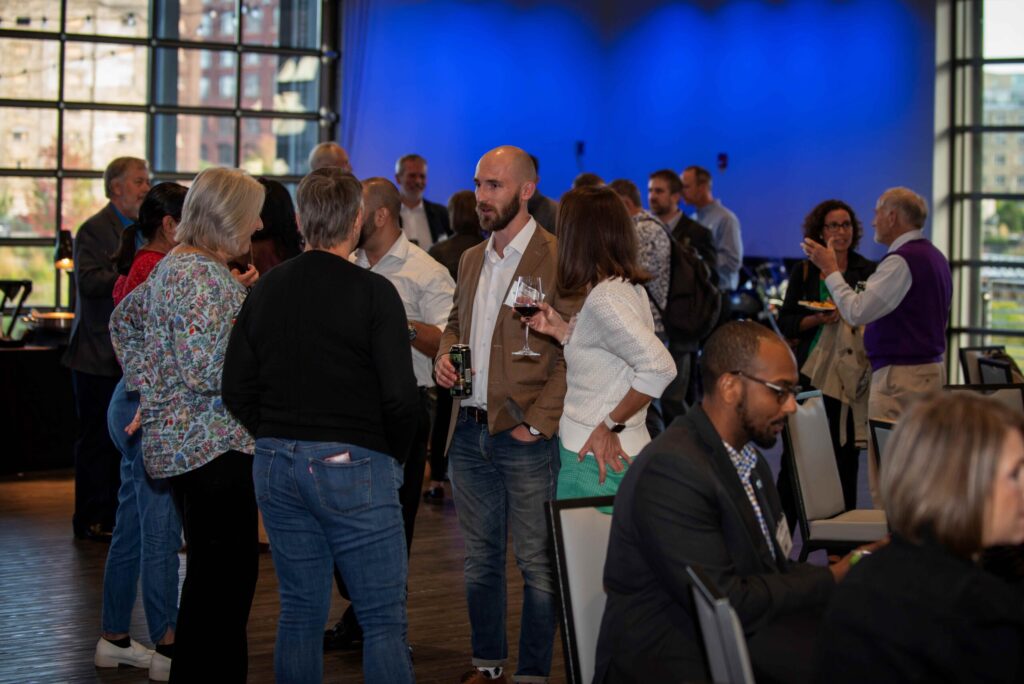Building Water Resiliency at our water leaders summit
 By Stacy Vogel Davis, Communications Director
By Stacy Vogel Davis, Communications Director
The Water Council has focused heavily on the concept of resiliency lately.
Resiliency – defined as the capacity to withstand or to recover quickly from difficulties – is important to many of our members working in water technology, water and wastewater utilities, and water stewardship. We know climate change will only heighten difficulties such as water scarcity, flooding and contamination and increase the demand for solutions.
In spring, The Water Council and our partners received a $1 million grant from the National Science Foundation to develop a Regional Innovation Engine focused on water and energy resiliency for manufacturers and utilities.
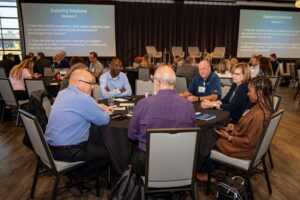
So it made sense for resiliency to be the theme of our 2023 Water Leaders Summit, held Sept. 13 and 14 in our hometown of Milwaukee, Wis. Each year, the summit draws water and sustainability professionals from across the country to discuss pressing water issues and network with fellow leaders in the water sector.
The theme resonated with the audience. We saw plenty of nodding heads and scribbled notes during the panel discussions. During our roundtables, participants had plenty to say about ways to speed up the innovation process, whether through university research, entrepreneurship, corporate R&D or some other method.
Here are some other takeaways from the event:
Innovators have solutions, but the process is frustratingly slow.
“Technology is the easiest part of solving a problem,” panelist Paige Peters declared. “It’s people, money, regulations that are challenging.”
Peters is the founder of Rapid Radicals Technology, a startup working to commercialize a high-rate wastewater treatment technology. The company is currentlyin the piloting stage with three employees.
“It took us a long time to learn that this pace is OK,” she said. “What we learned is when we’re ready to start selling, which is now, we have the information we need.”

Roger Berry is CEO of the chemical company Sudoc. Sudoc’s oxidation technology has applications in many sectors, including water, but the company isn’t currently focused on water.
“The water industry is pretty slow to make decisions,” he said. For now, Sudoc is targeting sectors such as industrial cleaning that can help it grow quickly.
A lack of regulations can also hurt water innovators, said Matt Stuyvenberg, vice president for water quality at Badger Meter. “There are solutions out there for years and years and years that are left to languish because there is not the push from regulators to adopt them,” he said.
Berry used the example of pharmaceuticals in wastewater. Europe is starting to regulate these contaminants, but the U.S. is not. Therefore, utilities have little incentive to adopt technologies that filter pharmaceuticals out.
Still, we heard success stories at the summit as well. Our final panel featured resiliency solutions in practice. We heard from Paul McRoberts of Rockwell Automation about solving challenges treating mining wastewater in West Virginia. Lindsay Birt, client solutions manager at Xylem, spoke of helping to solve sewer overflow issues in South Bend, Indiana. Michael Samuel, president of Nobel Systems, told us how he used his GIS technology to help communities solve water problems in Nepal.
Water scarcity remains a thorny challenge.
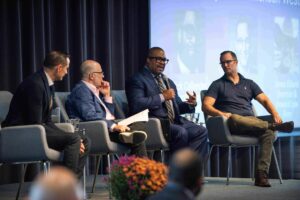
In a nod to popular demand, we held a panel on water in the American West for the second year in a row with return panelist James Eklund, a water attorney and Colorado rancher. Joining him were Rick Callender, CEO of Santa Clara Valley Water District, and Noah Sabich, managing director at Cimbria Capital.
After two panels on the topic, it remains clear that there are no easy answers. There is more demand for Colorado River water than there is supply, divided between the interests of communities, corporations and – to the tune of 80% — agriculture. That raises the potential that states could have to choose between sending water to households or to the farms that grow the food we eat.
“You can take shorter showers all you want and install low-flow fixtures, but if you want to get to the volumes we’re talking about in Lake Powell and Lake Mead, you’ve got to go to agriculture,” Eklund said.
Environmental justice is also a critical factor, the panelists agreed. Eklund acknowledged that his ranch was formerly indigenous land, while Callender spoke of how Black people were unfairly shut out of economic growth in the West from the time of slavery on.
“When government sanctions racism, it rests with the government to fix what they did,” Callender said.
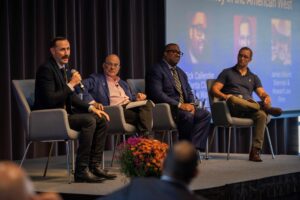
All the stakeholders must work together on solutions, no matter where they draw their water from, Callender added. For example, Santa Clara Valley doesn’t rely on Colorado River water, but the district must pay attention to what’s happening around it.
“It’s one big puzzle,” he said. “We can’t just take out a piece and ignore what’s going on down there. We all suffer together.”
Eklund reiterated the point.
“Old white guys sitting in a room ain’t gonna get it done,” he said. “We need bold, fresh ideas.”
We need to get creative about solutions.
The need for bold ideas and creative solutions was a theme throughout the summit.
One agency that’s trying something new is the National Science Foundation (NSF). The Regional Innovation Engine program that The Water Council is participating in is different from anything the NSF has done before, said Daniel Goetzel, entrepreneurial lead for the program.
“We are thinking meaningfully about how you transform communities,” said Goetzel, who called the program “the largest innovation and economic development initiative in the history of the federal government.
That means thinking intentionally about how to quickly build up ecosystems in regions across the country and discover solutions to challenges such as climate change, including a focus on use-inspired research and workforce development. The program is committed to transparency at every step and encourages collaborations among the various engines.
We also heard from Danica Starks of the World Bank and Ellie Collinson of the U.S. Trade & Development Agency about how those agencies can help companies work on infrastructure projects in developing nations while providing a dependable source of funding. Samuel, of Nobel Systems, explained how he used funding from the Asian Development Bank to grow exports in Nepal and the Philippines.
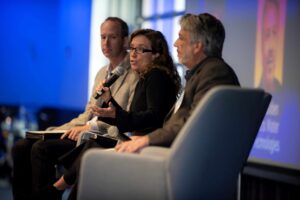
Cindy Bohlen of Riverwater Partners, a sustainable investment firm, and Alan Gilden of Watts Water Technologies explained that water technology isn’t the only consideration in building resiliency.
Corporate water stewardship is an important factor, Gilden said. Gilden led Watts through The Water Council’s WAVE: Water Stewardship Verified process to identify and mitigate water risk. For example, the company identified a facility in Fort Worth as one of its highest water consumers. When it replaced that facility, it was able to change its processes to reduce water consumption and hazardous waste.
“Shining a light on where we were using water changed a lot of things,” he said.
Investors need to use their voice with portfolio companies and policy makers to emphasize the importance of water in business operations, Bohlen said. Although water is relatively cheap, losing access will hurt businesses.
“If we don’t take care of the water situation for everyone, it will cause problems for everyone,” she said.
Although the water challenges are many, I left the summit with a sense of hope after seeing how many talented people are invested in solving them. If you missed this year’s summit, stay tuned to our website to learn about next year’s event.
